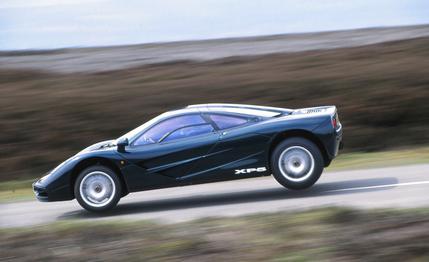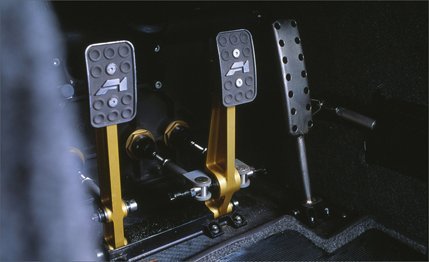
 Archived Road Test
Archived Road Test




It's flying.
An instant after being launched by a hump in the road at over 100 mph, my view of the sky from the central driving position of the McLaren Fl supercar is pure Cinemascope. The moon could be our destination. In that airborne instant, I believe anything is possible. Forget the moon—with an engine this potent, let's aim for Mars.
When the four-point touchdown comes, it is so velvety that the suspension feels as though it might have been designed for landings. Instantly, the sound of rushing air is shattered by a sharp bark from the engine as the $815,000 McLaren is propelled down the blacktop, accelerating at a rate I've never before experienced. Foot down hard, the straight vanishes. As the speedo needle hits 125 mph, an instant shift—so precise and mechanical it's like pulling back a well-oiled bolt on a rifle—brings fourth gear and another disorienting burst of power that thrusts me forcefully back into the tight-fitting bucket seat.


Still we accelerate. Just 5.4 seconds later, a green up-shift light flashes, appropriately positioned at the 7500 rpm redline on the tach in the center of the instruments. Into fifth gear at 150 mph. Still no lessening of acceleration thrust. The car—squat, stable, a green limpet on the road—shoots forward. Maybe there's space before the corner to grab sixth at 180 mph. Maybe.
No. My courage runs out, the survival instinct takes over. Onto the brakes. I press hard, through the pedal's inert feel before they bite to blunt forward movement.
Less than 30 seconds earlier, I'd waited back up the road for an all-clear signal. Even as the BMW V-12 idled evenly at 900 rpm, I could sense its invincibility. The exhaust note might be subdued, but caress the throttle and the revs soar. I can't resist. Nobody could. This engine responds so instantly it feels as if it doesn't have a flywheel, like a racing engine. The induction bellow is almost ephemeral it can be timed so accurately. The tach needle jerks savagely around the gauge, as if directly connected to the crankshaft.


I'm alone at last, able to contemplate the enormity of a car so swift that it demands an utterly different mental approach. The McLaren forces restraint because there is no way to drive it legally—except on an autobahn or a racetrack—and even begin to probe the full extent of its power and speed. It's an event every time you floor the throttle, producing an irresistible desire to remain behind the wheel, to learn as much as possible about a car so intense in its focus, so single-minded in its approach, that I'm convinced even a top-ranked driver could own it for years and still not explore the outer limits of its staggering performance envelope.
Forget the Jaguar XJ220, Bugatti EB110, Ferrari F40—until now cars deserving to be called rapid. The McLaren blitzes them all. And we have the proof. Confirmed by the Datron optical test gear.
The numbers do the talking: The F1 blasts to 60 mph in 3.2 seconds. The Porsche 959, the previous production-car record holder, needed 3.6 ticks of the watch. We saw 100 mph in 6.3 seconds. The Ferrari F40 took two seconds longer. The McLaren hits 150 mph in 12.8 seconds, a smidgen longer than it takes Porsche's latest, greatest 911 to reach 100 mph. Put another way, the McLaren can accelerate as hard at 150 mph as a Ford Taurus can in first gear.
Zero to 200 mph takes 28.0 seconds. What's impressive is the figures show that above 125 mph, the Fl supercar accelerates faster than last year's McLaren MP4/8 Grand Prix race car.
The standing quarter-mile is dispatched in a dazzling 11.1 seconds at 138 mph—about a second quicker and 15 mph faster than any other supercar we've tested.